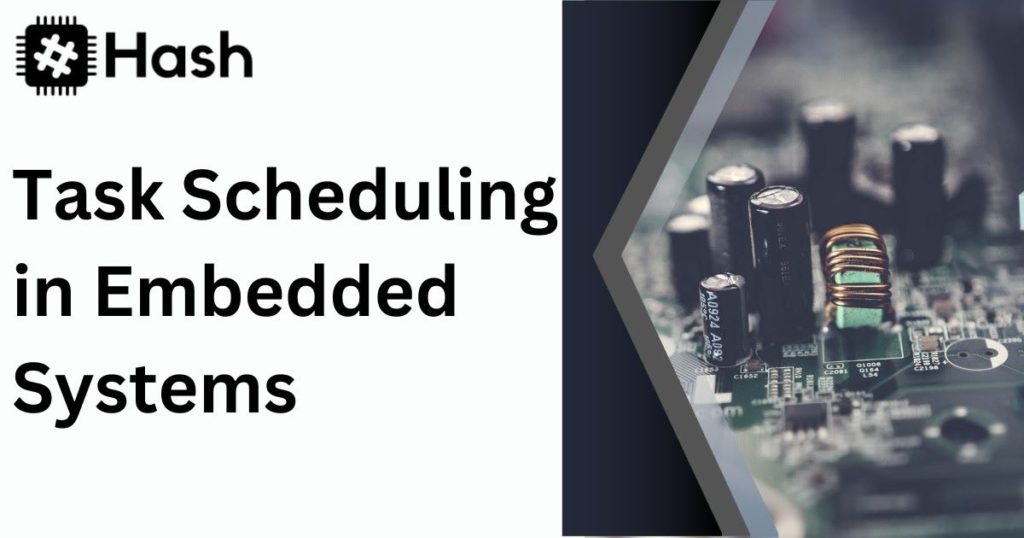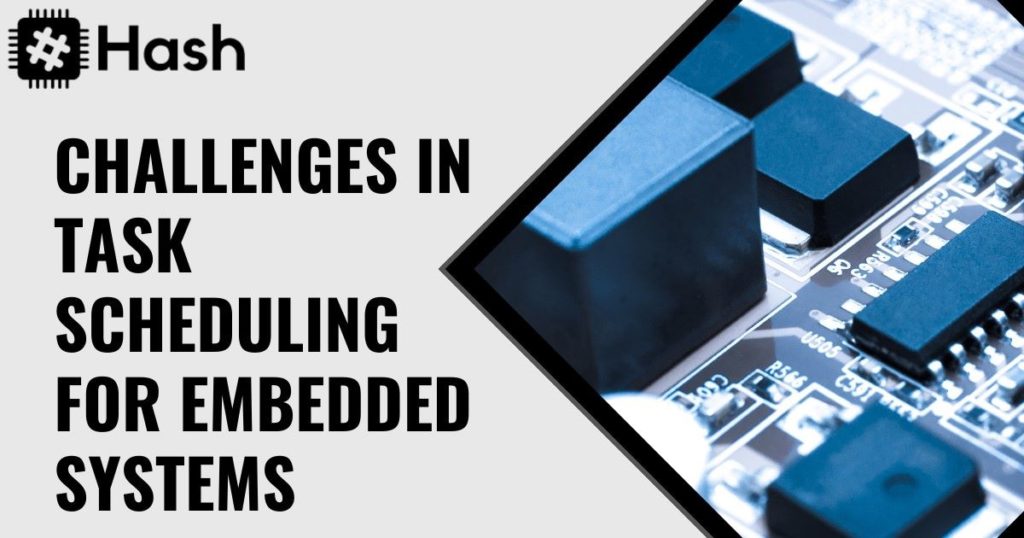The Importance of Task Scheduling in Embedded Systems
Task Scheduling in Embedded Systems
Embedded systems play a crucial role in our daily lives, often working behind the scenes to power various devices and technologies. From smartphones and smart home devices to medical equipment and automotive systems, embedded systems are at the heart of countless applications. These systems operate under strict constraints, requiring efficient management of tasks and resources to ensure optimal performance.
Task scheduling, a fundamental aspect of embedded systems design, plays a vital role in orchestrating the execution of tasks and achieving the desired functionality.
This article explores the importance of task scheduling in embedded systems, highlighting the challenges faced, the benefits it brings, and various scheduling techniques. By understanding the significance of task scheduling, developers can design more reliable, responsive, and efficient embedded systems.

Introduction
Task scheduling is an important aspect of embedded systems. It ensures that tasks are executed in a timely and efficient manner.
Overview of Embedded Systems
Embedded systems are computer systems that are designed to perform a specific function. They are typically designed to be compact and efficient, using a small amount of power and memory. Embedded systems are often used in real-time applications, where they must respond quickly to inputs and produce timely outputs.
In contrast to general-purpose computers, embedded systems are designed to be reactive and predictable. They are built for specific purposes and are programmed accordingly. The design of embedded systems involves close collaboration between hardware and software engineers to ensure that the system functions efficiently.
Definition of Task Scheduling
Task Scheduling in Embedded Systems is the process of determining the order in which tasks will be executed, tasks are typically executed in a round-robin fashion. In this approach, each task is given a time slice to execute; once the time slice is complete, the next task in the queue is executed.
Task scheduling algorithms can vary depending on the requirements of the system. Some systems may require a priority-based approach, where high-priority tasks are executed before low-priority tasks. In other systems, tasks may be scheduled based on their deadlines or their dependencies on other tasks.
Importance of Task Scheduling in Embedded Systems
Task scheduling is critical for the efficient operation of embedded systems. In real-time applications, it is essential that tasks are executed in a timely manner. Delayed execution can lead to missed deadlines and degraded performance.
Task scheduling also plays a role in the optimization of system resources. By scheduling tasks efficiently, the system can make the best use of its processing power and memory. This can improve performance and reduce power consumption.
Overall, task scheduling is a crucial aspect of embedded systems. It plays a vital role in ensuring that tasks are executed efficiently and in a timely manner. The design of task scheduling algorithms can have a significant impact on the performance and efficiency of embedded systems.
Basic Concepts of Task Scheduling
Task scheduling in embedded systems involves assigning tasks to be executed at specific times using scheduling algorithms. These algorithms ensure that all the tasks running on the system are executed efficiently, and promptly, while allocating resources and processing power optimally.
Real-Time Systems
A real-time system is a system that reacts to external stimuli within a strict time limit. They are used in safety-critical applications such as medical devices, manufacturing units, and avionics. Real-time systems require an efficient task scheduler as the timely response is of the utmost importance in these types of systems.
Types of Task Scheduling Algorithms
Preemptive Scheduling
Preemptive scheduling permits the interruption of tasks currently running by interrupt requests that have a higher priority. A task can be interrupted and resumed based on the priority levels of the tasks waiting to be executed. It is suitable for real-time systems that require prompt responses and have multiple high-priority tasks.
Non-preemptive Scheduling
In non-preemptive scheduling, tasks are executed until they are finished. The system can only execute the next task when the previous one is complete, ensuring that each task will run to completion. It is a simple approach that works well when the tasks are executed quickly, but it may cause longer delays in their execution in real-time systems.
Priority-Based Scheduling
Priority-based scheduling is an algorithm for executing tasks based on the priority assigned to them. It ensures that high-priority tasks are executed before low-priority tasks. It’s highly suitable for real-time systems, preventing the delays of critical task execution.
Round-Robin Scheduling
Round-robin scheduling is a time-sharing approach to task scheduling in embedded systems. Each task is given a specific time slice before the next task in the queue is scheduled to be executed. It’s highly suitable when multiple tasks execute simultaneously, without surpassing the time limits allocated to each of them.
Rate Monotonic Scheduling
Rate-monotonic scheduling is a priority-based scheduling algorithm, where tasks are assigned priorities at a fixed rate. This ensures that the highest-priority task is always executed first, which makes it suitable for real-time systems.
- Earliest Deadline First Scheduling
This scheduling algorithm ensures that tasks with the shortest deadlines are allocated to high-priority tasks first. The algorithm continuously adjusts the timing of the priority assignments according to the actual run-time behavior of the tasks.
Challenges in Task Scheduling for Embedded Systems
Task scheduling in embedded systems is challenging due to certain constraints and requirements that must be met to ensure the optimal execution of tasks.
Below are some of the challenges associated with task scheduling in embedded systems.
Resource Constraints
Embedded systems often have limited resources, such as processing power, memory, and storage. The task scheduler must work within these constraints to allocate resources efficiently to ensure all the tasks can be executed effectively. This challenge is particularly significant in real-time systems, where the system must respond quickly to external stimuli.
Determinism and Timing Requirements
Determinism is essential in the execution of tasks in embedded systems. Tasks must be executed in a specified order with predictable timing, and the task scheduler must ensure that all tasks are completed within set deadlines. This challenge is particularly demanding in real-time systems, where the response time is critical.
Handling High-Priority Tasks
In embedded systems, there are often tasks with higher priority, which means they need to be executed before other tasks. The task scheduler must ensure that these high-priority tasks are executed within their respective deadlines while balancing other tasks with lower priorities. The task scheduler must also account for the possibility of new high-priority tasks arriving while lower-priority tasks are being executed.
Interference and Resource Contention
Interference and resource contention pose a significant challenge in task scheduling. Interference occurs when tasks interfere with one another, leading to degraded performance, and resource contention occurs when two or more tasks compete for a single resource at the same time. Task scheduling in Embedded Systems must manage interference and resource contention effectively to maintain optimal system performance.
Synchronization and Deadlocks
Long-running tasks may require synchronization mechanisms such as locks and semaphores. The task scheduler must ensure that multi-process tasks execute in the correct order to avoid deadlocks, where task Scheduling in Embedded Systems must wait indefinitely for a particular resource, leading to system hangs.

Benefits and Advantages of Effective Task Scheduling in Embedded Systems
Effective task scheduling is essential for the efficient operation of embedded systems. Below are some benefits and advantages of effective task scheduling in embedded systems.
Improved System Performance and Responsiveness
Effective task scheduling in embedded systems ensures that all tasks and processes are executed efficiently and without delays. Task scheduling in Embedded Systems has an algorithm that reduces the wait times and significantly improves system responsiveness, resulting in an overall better user experience.
Predictability and Determinism
Task scheduling algorithms provide predictability and determinism in the execution of tasks, which is essential in time-critical applications. It ensures that tasks scheduled in Embedded Systems execute according to their priorities, deadlines, and processing requirements, leading to the desired results.
Optimal Resource Utilization
Effective task scheduling provides optimal resource utilization by allocating resources such as memory, processing power, and storage efficiently. The task scheduler optimizes the allocation of these resources, allowing for the best possible system performance, particularly in resource-limited embedded systems.
Meeting Real-Time Constraints
In real-time embedded systems, meeting timing constraints is essential, and effective task scheduling ensures that all tasks meet their necessary real-time requirements. Task schedulers ensure that high-priority tasks execute within their specified deadlines and that no tasks suffer from deadline misses due to resource constraints.
Energy Efficiency
Effective task scheduling can contribute to energy efficiency in embedded systems by reducing the consumption of resources such as power. Embedded systems are often limited in their energy supply, and efficient task scheduling can help in reducing energy consumption, leading to longer battery life and lower power costs.
Task Scheduling Techniques and Strategies
Task scheduling techniques and strategies play a critical role in achieving efficient execution of tasks in embedded systems. Below are some important techniques and strategies used in task scheduling in embedded systems.
Static vs. Dynamic Scheduling
Static scheduling involves assigning fixed time slots to tasks during compile-time or system configuration. It is suitable for applications with well-defined and predictable task behavior. Static scheduling provides deterministic execution and low overhead.
However, it may not be flexible enough to handle dynamic task arrivals or changes in task priorities. On the other hand, dynamic scheduling adapts the task execution based on runtime conditions and priorities. It offers more flexibility but may introduce higher overhead due to runtime scheduling decisions.
Periodic vs. Aperiodic Tasks
Tasks in embedded systems can be categorized as periodic or aperiodic. Periodic tasks have regular arrivals and fixed execution intervals. They often have strict timing constraints and deadlines to meet.
Aperiodic tasks, on the other hand, have irregular arrivals and may have varying execution intervals. Effective task scheduling must handle both periodic and aperiodic tasks, ensuring that deadlines are met for periodic tasks while efficiently accommodating aperiodic tasks without adversely impacting system performance.
Task Prioritization and Scheduling Policies
Task prioritization is an essential aspect of task scheduling in embedded systems. It involves assigning priorities to tasks based on their relative importance and criticality. The task scheduler uses scheduling policies to prioritize and determine the order of task execution.
Common scheduling policies include rate-monotonic scheduling (RMS), earliest deadline first (EDF), priority-based preemptive scheduling, and round-robin scheduling. The choice of scheduling policy depends on the application requirements and the importance of meeting task deadlines.
Task Partitioning and Mapping
In complex embedded systems, tasks may be divided into smaller sub-tasks or threads to improve efficiency and resource utilization. Task partitioning involves breaking down large tasks into smaller ones that can be executed concurrently or in parallel.
Task mapping refers to assigning these sub-tasks to appropriate processing units or cores in a multicore system. Efficient task partitioning and mapping strategies ensure that the workload is balanced across processing resources while minimizing communication overhead and maximizing system performance.
Task Synchronization and Communication
Tasks in embedded systems often need to communicate or synchronize their operations. Synchronization mechanisms like locks, semaphores, and message queues are used to coordinate access to shared resources or to ensure proper ordering of task execution.
Efficient task scheduling ensures that tasks requiring synchronization or communication are appropriately coordinated to avoid deadlocks, race conditions, or resource contention issues.

Tools and Frameworks for Task Scheduling
Several tools and frameworks are available to support task scheduling in embedded systems. These tools assist in the development, analysis, and simulation of task scheduling algorithms and provide libraries and APIs for implementing task scheduling functionalities. Below are some commonly used tools and frameworks for task scheduling in embedded systems.
Real-Time Operating Systems (RTOS)
Real-Time Operating Systems (RTOS) are specifically designed to handle the scheduling and execution of real-time tasks in embedded systems. These operating systems provide task scheduling capabilities and real-time features, such as task prioritization, preemption, and deterministic execution.
RTOSes offer scheduling policies and mechanisms that ensure tasks meet their deadlines consistently. Popular RTOSes used in embedded systems include FreeRTOS, VxWorks, QNX, and eCos.
Scheduling Analysis and Simulation Tools
Scheduling analysis and simulation tools are widely used in the development and validation of task scheduling algorithms. These tools provide insights into the behavior and performance of task schedulers by analyzing the execution patterns and detecting possible issues, such as deadline misses or resource contention.
Scheduling analysis tools often incorporate various scheduling policies and mechanisms to simulate the behavior of task schedulers under different scenarios. Some popular scheduling analysis and simulation tools include Simulink, MATLAB, and C-based scheduling analysis frameworks like Cheddar and Chronos.
Task Scheduling Libraries and APIs
Task scheduling libraries and APIs provide ready-to-use functionalities for implementing task scheduling in embedded systems. These libraries and APIs encapsulate the complexities of task scheduling algorithms and provide an interface to manage and control the scheduling of tasks.
They offer functions for task creation, prioritization, scheduling policies, synchronization, and communication between tasks. Libraries like POSIX threads (pthread) and Windows threads (Win32 threads) provide task scheduling capabilities in multi-threaded environments.
Additionally, some specific task scheduling libraries, like the LEDBAT library for TCP/IP-based network applications, focus on optimizing task scheduling for specific domains.
Conclusion
In conclusion, task scheduling is a fundamental aspect of embedded systems that deserves careful consideration and implementation. By prioritizing tasks, optimizing scheduling algorithms, and utilizing available tools and frameworks, we can ensure that embedded systems operate reliably, efficiently, and in accordance with their real-time requirements.
We explored various tools and frameworks that support task scheduling in embedded systems. Real-Time Operating Systems (RTOS) provide task scheduling capabilities with real-time features, allowing for deterministic execution and prioritization of tasks.
Scheduling analysis and simulation tools aid in the development and validation of task scheduling algorithms, providing insights into the behavior and performance of task schedulers. Task scheduling libraries and APIs offer ready-to-use functionalities for implementing task scheduling in embedded systems, simplifying the development process and optimizing system performance.
By properly implementing task scheduling in embedded systems, we can ensure efficient resource utilization, timely task execution, and improved system reliability and performance.
Task scheduling in Embedded Systems enables the system to handle concurrent and periodic tasks, meet critical deadlines, and respond in real-time to external events. With the help of tools, frameworks, and an understanding of task scheduling techniques, developers can design and optimize task schedulers that meet the requirements of embedded systems in different domains.
Frequently Asked Questions: Task Scheduling in Embedded Systems
Task scheduling in embedded systems refers to the process of managing and allocating system resources to various tasks or processes running on the embedded system. It involves determining the order and timing of task execution to meet timing constraints, ensure efficient resource utilization, and achieve desired system behavior.
Task scheduling is crucial in embedded systems because it ensures the timely execution of critical tasks, meets real-time requirements, and maximizes resource utilization. Effective task scheduling improves system performance, responsiveness, and reliability, allowing embedded systems to function smoothly and meet their intended functionality.
Some common challenges in task scheduling for embedded systems include resource constraints, determinism, handling high-priority tasks, interference and resource contention, and synchronization and deadlocks. These challenges must be addressed to ensure that tasks are scheduled efficiently and meet the system’s real-time requirements.
There are various types of task scheduling algorithms used in embedded systems, including preemptive scheduling and non-preemptive scheduling. Preemptive scheduling allows higher-priority tasks to interrupt lower-priority tasks, while non-preemptive scheduling completes the execution of one task before starting another. Other scheduling algorithms include priority-based scheduling, round-robin scheduling, rate monotonic scheduling, and earliest deadline first scheduling.
Effective task scheduling directly impacts system performance by ensuring that tasks are executed in a timely manner. It helps prevent task delays, reduces response time, and improves overall system throughput. Proper task scheduling enables efficient utilization of system resources, resulting in optimized system performance.
Optimal task scheduling in embedded systems offers several benefits, including improved system performance and responsiveness, predictability and determinism, optimal resource utilization, meeting real-time constraints, and energy efficiency. These benefits contribute to the overall reliability and efficiency of the embedded system.
Yes, there are tools and frameworks available for task scheduling in embedded systems. Real-time operating systems (RTOS) provide built-in task scheduling capabilities. Additionally, there are scheduling analysis and simulation tools, as well as task scheduling libraries and APIs, which assist developers in designing and implementing effective task scheduling strategies.
Task scheduling in embedded systems can be optimized by following best practices such as task modeling and analysis, proper task design and implementation, thorough testing and validation, and continuous monitoring and performance analysis. Adhering to these practices ensures efficient task scheduling and improves the overall performance of embedded systems.
Machine learning techniques can be employed for task scheduling in embedded systems. By using historical data and learning algorithms, machine learning models can predict task execution times and adjust scheduling decisions dynamically, adapting to changing system conditions. This approach can enhance task scheduling efficiency and adaptability in complex embedded systems.
Future trends in task scheduling for embedded systems include the development of adaptive and dynamic scheduling approaches that can handle changing workloads and system conditions. There is also ongoing research in machine learning-based task scheduling, security and safety considerations, and task scheduling for emerging technologies such as cyber-physical systems and edge computing.



 embeddedhash.in@gmail.com
embeddedhash.in@gmail.com